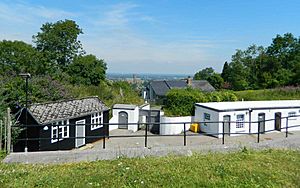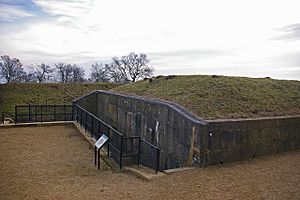London Defence Positions facts for kids
The London Defence Positions were a plan from the late 1800s to protect London from invaders. Imagine a long line of trenches and small forts built around the city! These were designed to be quickly dug and used if an enemy army landed on England's south coast.
The plan included thirteen special small forts called London Mobilisation Centres. These forts were like supply depots. They held all the tools, weapons, and ammunition that soldiers would need to dig the trenches and defend the area in a hurry.
Why Were They Built?
Back in 1859, a special report looked at Britain's defences. It said that London was very hard to protect. Later, in 1888, a military expert named Colonel John Charles Ardagh came up with a new idea.
He suggested building simple earthworks, which are like large ditches and mounds of earth. These would be dug by volunteer soldiers if there was an emergency. To help these volunteers, permanent forts, the London Mobilisation Centres, would be built every 8 kilometres (5 miles). These centres would store supplies and act as strong points along the defence line.
The government minister for war, Edward Stanhope, announced this plan in March 1889. By then, the land for all 13 Mobilisation Centres had already been bought for about £25,000.
Where Were They Located?

The London Mobilisation Centres were spread out over 113 kilometres (70 miles). They followed a line along the North Downs hills from Guildford to the Darenth valley. They also crossed the River Thames into Essex.
The thirteen chosen spots included places like:
- Pewley Hill
- Henley Grove (now known as Henley Fort)
- Box Hill
- Reigate
- Halstead
- North Weald
Each fort was built a bit differently, but they were never very fancy. They mainly had a magazine (a place to store ammunition) and storehouses for troops and supplies. They also had some basic defences. The main idea was for these centres to be strong points in a long line of trenches that could be quickly dug if war broke out.
Other supply stores were set up nearby, for example, at Tilbury. However, these forts quickly became outdated. By 1907, most of them were sold off. Only Fort Halstead is still used by the government today for scientific research.
During World War I, parts of this old defence plan were brought back. A new line of trenches was planned in case Germany invaded. North of the Thames, the line went further to the River Lea. South of the Thames, it connected to the Chatham defences.
Today, houses stand on the Pewley Hill site in Guildford. But Henley Fort has been well looked after. It is now used as a youth education centre and can sometimes be visited on special open days.
Reigate Fort
Reigate Fort has been owned by the National Trust since 1932. Over the years, the fort started to fall apart. But thanks to money from the Biffaward, the Heritage Lottery grant, and the National Trust itself, the building has been restored.
The first part of the repairs happened in 2000 and cost £104,000. A second stage of work cost £174,000.
The fort opened to the public for free in 2007, and restoration work is still ongoing. Information boards have been put up to teach visitors about the buildings. There are also special resources for teachers, and schools can arrange educational visits.
See also
- Fortifications of London
- Outer London Defence Ring - a similar idea from World War II


